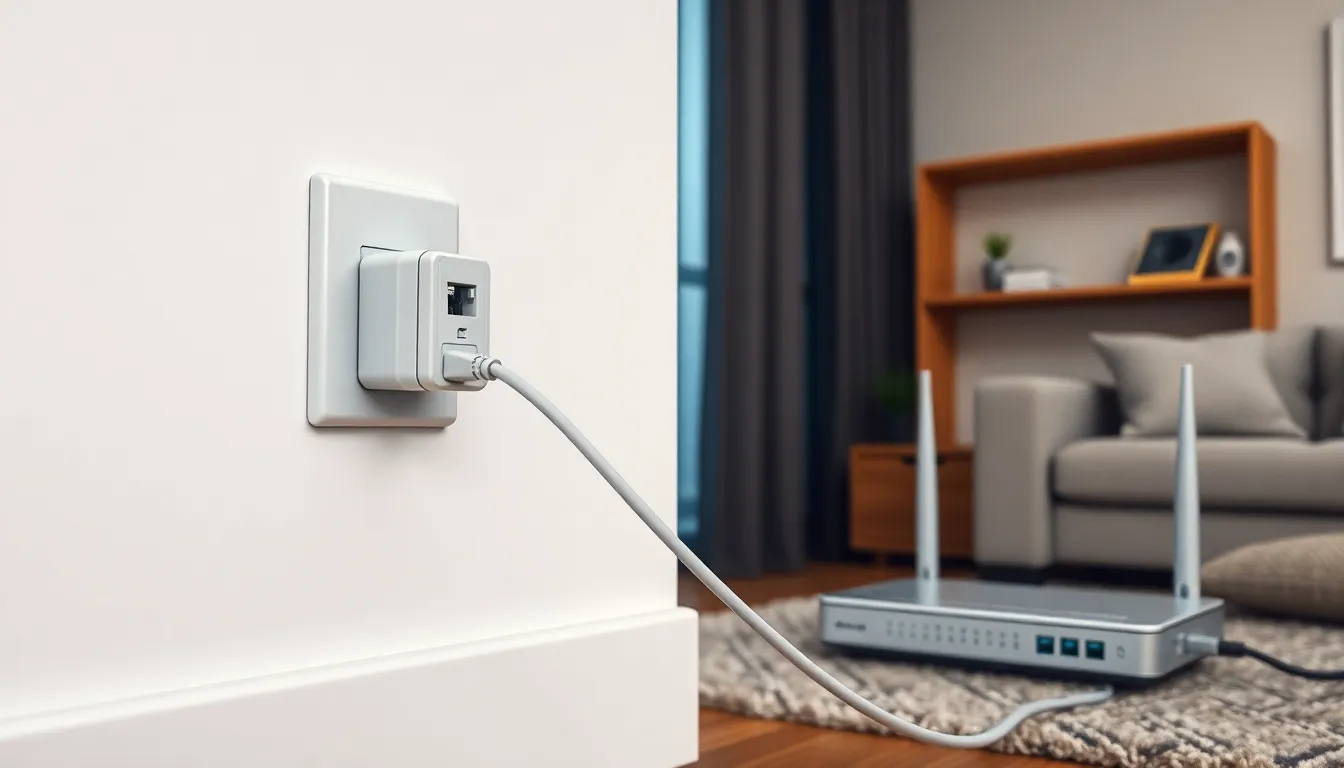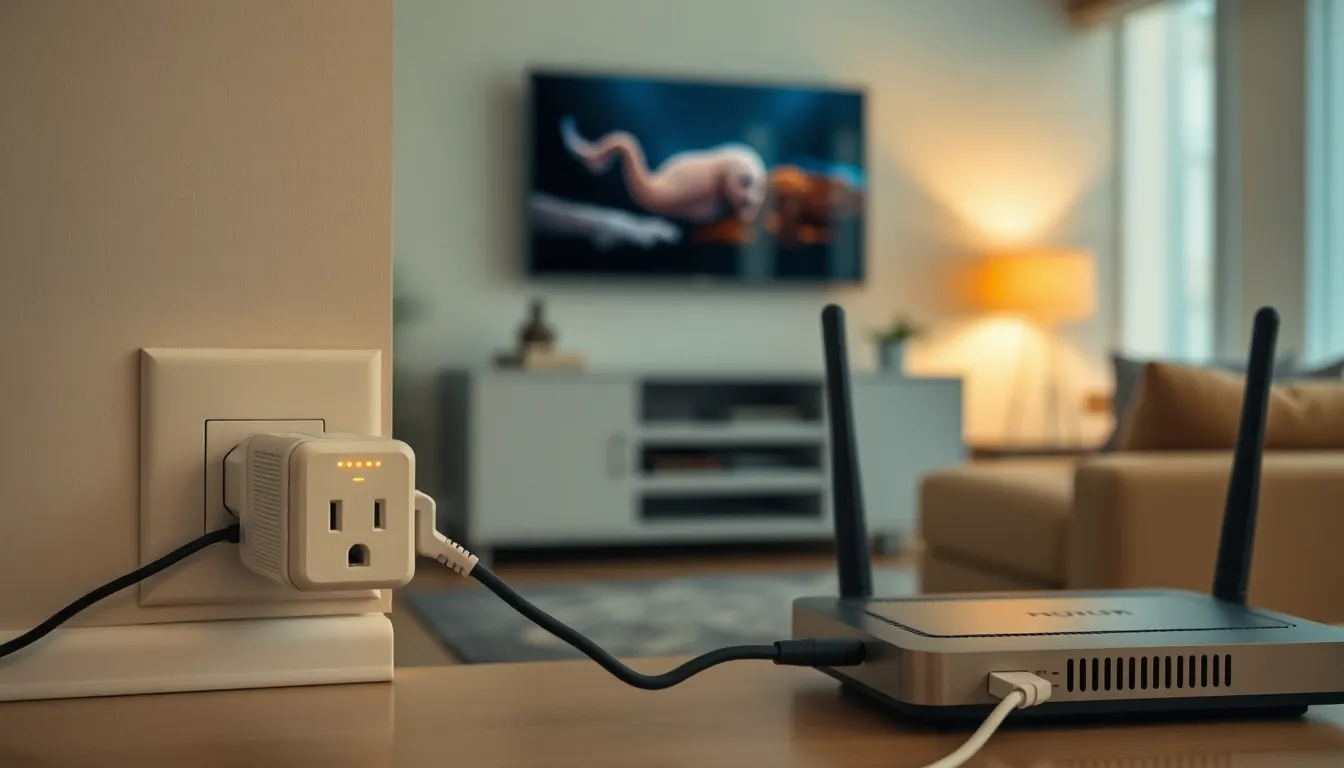In a world where Wi-Fi dead zones lurk like ninjas in the shadows, powerline adapters swoop in to save the day. These clever little devices use existing electrical wiring to extend internet connectivity throughout the home, ensuring that no corner is left behind. Imagine streaming your favorite show in the basement while your kids game upstairs without a hitch—sounds like a dream, right?
Table of Contents
ToggleOverview of Powerline Adapters
Powerline adapters enhance internet connectivity by utilizing existing electrical wiring. These devices create a network connection through power outlets, making them ideal for households with Wi-Fi dead zones. Within a typical setup, one adapter connects directly to the router while the other plugs into an outlet in a different room.
Installation occurs easily. Users plug in the adapters, connect one to the router via an Ethernet cable, and then pair the devices through a simple button press. The result is a more stable and faster internet connection without the need for extensive cabling or additional Wi-Fi extenders.
Data transmission speeds often reach up to 1,200 Mbps, depending on the model and electrical wiring conditions. Key features include support for multiple Ethernet ports and wireless capabilities. Not all models perform identically, so it’s essential to select one that matches specific needs.
Powerline adapters are not susceptible to common wireless interference factors like walls and microwaves. This advantage leads to consistent performance, especially for activities like online gaming or streaming high-definition content. Cost-effective solutions exist on the market, with prices typically ranging from $30 to $100, depending on speed and features.
Users enjoy flexibility with their placement. Devices can connect in any location accessible through an electrical outlet, extending internet access to basements, attics, or even outdoor spaces. Additionally, many powerline adapters come equipped with encryption features, ensuring secure data transmission across the network.
In sum, these devices offer an efficient and effective solution for enhancing internet connectivity within a home. By leveraging existing infrastructure, powerline adapters provide reliable access without the hassle of traditional wiring.
How Powerline Adapters Work

Powerline adapters utilize existing electrical wiring to transmit internet signals, bridging connectivity gaps throughout a home. This technology allows devices to communicate by sending data as electrical signals over power lines.
The Technology Behind Powerline Networking
Powerline networking relies on the HomePlug technology standard. HomePlug utilizes modulation techniques to convert data into signals compatible with electrical circuits. Electrical wiring acts as a network while avoiding degradation common to wireless signals. Typically, a powerline adapter connects to a router via Ethernet and communicates with another adapter plugged into a distant outlet. The setup results in reliable and stable connections throughout various rooms.
Types of Powerline Adapters
Powerline adapters come in different types to meet specific user needs. Standard models function mainly as wired connections, equipped with one or more Ethernet ports for direct device connection. Other models offer integrated Wi-Fi capabilities, facilitating wireless connections to devices like smartphones and laptops. Certain adapters feature power pass-through functionality, maintaining access to electrical outlets while providing internet connectivity. These variations ensure flexibility in addressing unique internet demands within a household.
Benefits of Using Powerline Adapters
Powerline adapters offer multiple advantages for enhancing internet connectivity in homes. They provide reliable connections, eliminate Wi-Fi dead zones, and facilitate a seamless online experience.
Improved Connectivity
Improved connectivity is one of the most significant benefits of powerline adapters. These devices leverage existing electrical wiring, ensuring consistent internet access throughout a home. Many users experience reduced latency, making online gaming and 4K streaming more enjoyable. Performance remains stable even in different rooms, where traditional Wi-Fi might falter. Capable of reaching data speeds of up to 1,200 Mbps, powerline adapters suit high-demand environments effectively. They maintain strong connections, increasing user satisfaction and productivity.
Easy Setup and Use
Easy setup and use distinguish powerline adapters from other solutions. Users connect one adapter to the router and plug it into a nearby power outlet. Simply pressing the pairing button establishes a secure connection between units. No complex configurations or installations are required, making them accessible for everyone. Convenience extends to their placement, as users can connect devices in any accessible electrical outlet. Multiple Ethernet ports on some models offer flexibility for various devices, further simplifying the user experience. Users appreciate getting online quickly and efficiently without significant effort.
Considerations When Choosing a Powerline Adapter
When selecting a powerline adapter, several factors must be taken into account to ensure optimal performance.
Speed Ratings and Performance
Speed ratings significantly impact user experience. Many models offer data transmission speeds of up to 1,200 Mbps, which is ideal for activities that require high bandwidth. Performance can vary based on electrical wiring conditions and distance between adapters. It’s crucial to understand that actual speeds may be lower due to interference and wiring quality. Users should consider their internet plans and usage requirements to choose a model that meets their speed needs. Brands often advertise peak speeds, so verifying real-world performance through reviews or tests helps in making an informed decision.
Compatibility with Existing Network Equipment
Compatibility plays a vital role in selecting a powerline adapter. Adapters must work seamlessly with existing routers, switches, and other network devices. Most models adhere to the HomePlug standard, ensuring interoperability among different brands. Users should check whether the adapter supports Ethernet ports for wired connections and whether it can extend Wi-Fi networks effectively. Verifying compatibility with devices like gaming consoles or smart TVs ensures smooth integration into a user’s home network. Researching product specifications leads to a better match with current equipment and desired functionality.
Popular Powerline Adapter Models
TP-Link TL-PA9020P Kit features dual-port connections, providing excellent speeds up to 1,200 Mbps. This model includes a power pass-through option, allowing other devices to connect without blocking outlets.
Netgear PL1200 Powerline Adapter excels in providing consistent connectivity, boasting a simple setup process. Its compact design fits easily into various electrical outlets, making it user-friendly for any household.
D-Link DHP-701AV model delivers impressive performance with speeds of up to 1,000 Mbps. This option includes advanced encryption for secure connections, making it ideal for families that prioritize online safety.
ASUS PL-AC56 Kit stands out with integrated Wi-Fi capabilities, merging powerline technology with wireless convenience. Users appreciate the versatility of connecting wired and wireless devices simultaneously, enhancing their overall internet experience.
Zyxel PLA5456 offers four Ethernet ports, enabling direct connections for multiple devices. This adapter ensures a stable internet connection throughout larger homes, accommodating various user needs.
TP-Link TL-WPA7517 extends connectivity further with wireless capabilities, perfect for users requiring a strong signal in dead zones. Plugging this model into an existing outlet quickly establishes a new Wi-Fi access point.
Each of these models provides unique advantages based on specific household requirements. Selecting the right adapter hinges on factors such as speed, connectivity options, and ease of installation. It’s essential to check compatibility with existing network equipment to ensure seamless integration.
Powerline adapters offer a practical solution for enhancing internet connectivity throughout homes. By leveraging existing electrical wiring, they eliminate Wi-Fi dead zones and ensure reliable connections for activities like streaming and gaming. Their straightforward installation process and various models cater to different user needs, making them an appealing choice.
With competitive pricing and features such as multiple Ethernet ports and wireless capabilities, powerline adapters stand out in the market. Users can enjoy reduced latency and improved performance, transforming their online experience. Selecting the right model based on speed, compatibility, and specific requirements will help maximize the benefits of this technology.





